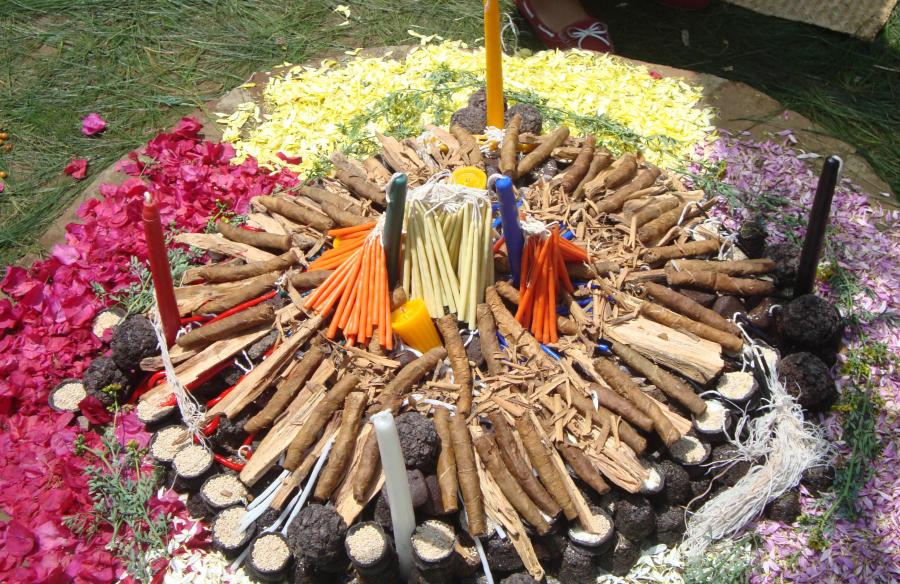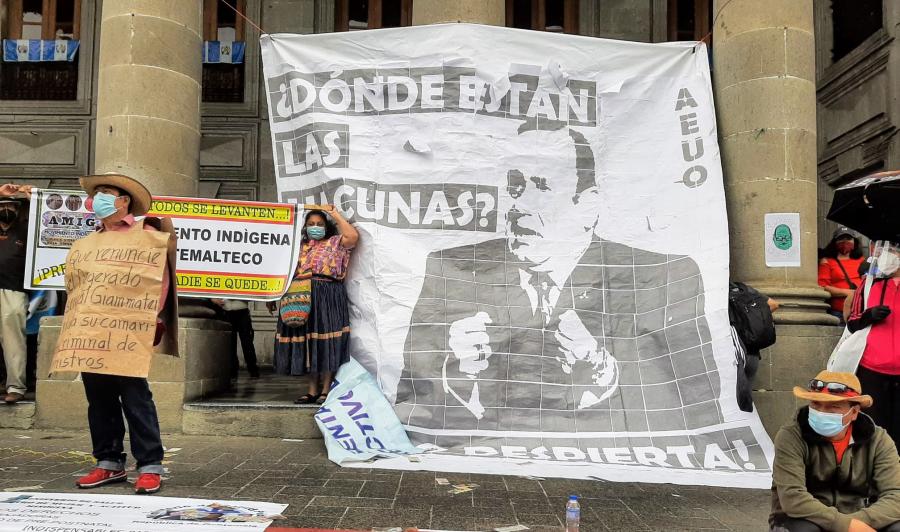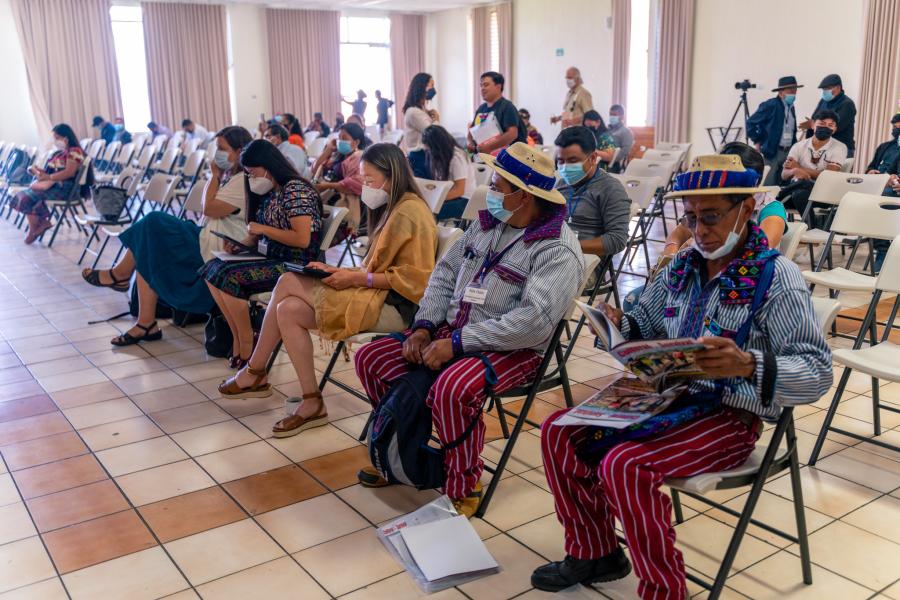Suddenly, voices of the dead, silenced for hundreds of years, are speaking out, revealing their names, their ages, their great accomplishments, even to a degree, their personalities. Suddenly, the Mayan heroes of Mexico and Central America engraved in stone, carved in wood a thousand years ago are emerging from ghostly images enveloped in mysterious glyphs.
A thousand years ago, the Mayan city states, overburdened by enormous population growth, tumbled one by one. The places and pyramids crumbled. But not all was lost. For another six hundred years Mayan knowledge was retained in myth and tale, ritual performance, the arts, painting and writing. These, too, were at risk when the Spanish conquerors arrived in the New World and speedily burnt all the books they could find, attempting to extirpate all traces of "heathen religion and demonology."
Of all the ancient books written in Mayan on the bark of trees, only four are known to survive today. But in Guatemala and Yucatan, as they learned the Roman alphabet, a few canny Mayan secretly wrote down their prophecies in their own language.
The grand adventure of deciphering the glyphs became successful when the epigraphers realized that some were phonetic and some ideographic (pictorial representations of objects and ideas), and that the vocabulary and grammar were similar to that found in Mayan languages spoken today. Exploring colonial dictionaries compiled by Spanish friars, as well as studying modern Mayan languages, they have been able to tease out the meaning of many glyphs and to discover the extraordinary continuity of images and even styles of speech.
In Guatemala, despite the terrible violence being wrought on the Mayans by the army, the Mayan languages have been incorporated into the constitution and bilingual education is spreading to the far corners of the country. Mayans are now having their children baptized with Mayan names, names of heroes forgotten for a millennium.
Just across the border, in Chiapas, Mexico's southernmost state, we are witnessing a similar rebirth or native pride. While its inhabitants have been spared the holocaust of Guatemala, they have endured five bitter centuries of domination and indignities.
Up until the 1950's, debt peonage in the coffee fincas was still carried out with brutality and total contempt for the Indian. At this time, the National Indian Institution (INI) appeared in San Cristóbal with the mission to "civilize" and assimilate the Indian. Viewed by the local mestizo population as Communists, the INI established bilingual schools, clinics, agricultural training centers, and eventually Indian-controlled stores and a huge network of roads. With INI guidance the Harvard Chiapas Project was established to study culture change, eventually involving over 100 students.
Literally hundred of Indians in the towns of Zinacantán and Chamula were paid to extend their knowledge to highly educated foreigners. The initial task of the project was to train its members to become fluent in the Mayan language, Tzotzil. As government education systems soon reverted to teaching education systems soon reverted to teaching only in Spanish, these individuals became special figures. Many of them later became prominent civil and religious leaders.
When the project lost its funding, three of the Indians associated with the project were eager to continue. With the assistance of the Mexican poet Jaime Sabines, brother of the then governor or Chiapas, they received a small grant from the state to fore a writer's cooperative. As a result, a book of tales and a Tzotzil primer were published by the state.
When state support ended abruptly in 1982, I urged them to state their case to continue the project before an international audience of anthropologists and linguists at a conference on the Chiapas Project in San Cristóbal. Dramatically, they explained, "You have published many studies, but always in other countries where we never see the results. Our young people are now literate in Spanish but they don't know a quarter of what their fathers or their grandfathers know about our culture. When the elders go to the grave they take their knowledge with them. We would like, at least, to put on paper our customs for the sake of our children and grandchildren." The scholars rallied to the cause, and seed money was secured from Cultural Survival.
And so was born Sna Jtz' ibajaom, the House of the Writer.
They soon added two Tzeltel speakers. INI gave them office space, and the government published their bilingual booklets. The new booklets gave the people of Chamula and Zincantán the earliest Spanish descriptions of their encounters with the Indian in their own dialect of Tzotzil. They also recorded folk tales and described customs that are now becoming part of the past.
We soon learned that these bilingual booklets designed so that each Tzotzil or Tzeltal paragraph was matched with its Spanish translation, were being read only in Spanish. The school system, not bothering to teach literacy in the native languages had encouraged an Indian ignorance and disdain difficult to surmount. Spanish was the language of civilized people; why bother with the other?
Frequently Indian teacher are assigned to schools in communities where another language or a different dialect of their own language is spoken. They teach in a language barely known by the children. Rarely do they teach them how to write narratives or to read with understanding the words they see lined up before them.
The atmosphere in which a Mayan child learns at ho,me is strikingly different from that in the schoolroom. At home the child learns by observation, demonstration, limitation and joint participation. The parents are concerned with his or her social behavior, adoption of values, and the development of work skills, as well as the process of maturation. A marked degree of independence and active participation is fortified by the confidence placed in him or her by the parents. At school the child is faced with a dominating culture with different values. Frequently the teacher expects little from his students and spends little from his students and spends little checking their progress. The principal means of instruction is verbal and limited to school materials.
In 1988 we decided to tackle the problem head-on. With the counsel of the cooperative I worked with three young men who initiated a pilot literacy project in Zincantín. Within a week they were all reading Tzotzil fluently. The alphabet that we had invented and refined during the years of the Harvard project seemed adequate to them.
We decided to offer a six month course with the teachers teaching their neighbors out of their own homes - two evenings a week for two hours, with no age limit. Tour surprise, men, women and children lined up, aged from 10 to 60. Though they knew Tzotzil literacy would provide them few if any jobs, their motivation was very simple. As they said,"We want to be smart!" In 3 1/2 years we have awarded nearly 1500 diplomas, perhaps a 400-year record for literacy in a native language in Mexico among traditional Indians.
This supplementary school system can boast that every one of its teach and every one of its students wants to learn. In a society where sexual division of labour is very strong, and respect for age highly marked, it is amazing to see these distinctions dropped in a home atmosphere while everyone tries to help everyone else learn.
At the beginning of the course the teachers learned that Tzotzil is one of 30 Mayan languages, not a mere dialect as they had heard all their lives. I showed them my Tzotzil dictionary (Laughlin, 1975)with 30,000 words, a number higher than anyone dreamt.
I also showed them how a single Mayan root can produce 20 to 30 words: ritual speech, baby talk, jokes, descriptions of slow movement, frenetic movement, repeated movement, etc. - a treasury of ideas than form part of their daily life. Choosing the roots, the teacher can activate his students to contribute a pile of words derived from the root. You can see the people's joy, their jokes and enthusiasm as they watch the words that have just left their mouths jump upon the blackboard.
Two years ago, 20 teachers in the federal school system in Chamula, whose monolingual Tzotzil students were learning practically nothing, and realizing that they themselves were illiterate in their own language, asked for our training. Roughly half were awarded diplomas. This is a major breakthrough in professional teachers' attitudes. With state recognition it has become clear to the populace that Tzotzil literacy has contributed greatly to their confidence and ability to learn Spanish. It has encouraged students to enter pieces of Tzotzil creative writing in state competition, and ten of them won national prizes this year for their bilingual literacy creations.
To increase interest in our publications, in 1985 we hired Amy Trompetter of the Bread and Puppet Theatre of the Bread and Puppet Theatre to give us a two-week workshop so that we could out the contents of our booklets to make papier machè puppets, how to put them in motion and how to make a portable theater. In two weeks the Teatro Lo'il Maxil, Monkey Business Theatre, was on the road.
Of this theater's ten satires, seven are based on traditional tales. The actors write the dialogue in Tzotzil, Tzeltal and Spanish and learn the line by heart, but there is tremendous liberty and creative invention and improvisation when the hand puppets are in action. One of the satires presents the education of children, first under the disastrous efforts of the monolingual Spanish teacher followed by the success of the bilingual Indian teacher. This ia a real favorite.
In 1989, when the puppeteers wished to create a legitimate theatre, we hired Ralph Lee, director of the Mettaweee River Company in New York. Although Ralph arrived with no command of Spanish, his train-ing in mime did the trick. Every year the members of San provide material to our Francisco of San provide material to our Francisco Al-varez to write the script for anew play. In a month's time, under Ralph's direction, and with the collaboration of all the members, a play is created.
The first two were based on local Mayan folktales, the third was based on "gossip" (a murder case in a neighboring town), and a growth with the Spanish Conquest, the Quiché Mayan Book of Counsel, the Popol Vuh, and the epic lives lot the Classic mayan kings of Yaxchilán.
Whether performed in Spanish or in a Mayan language, these plays represent not only the magic and supernatural elements of their lives,but also the pleasures and sufferings of Mayan daily life. A fifth play, adapting a Tzeltal folktale was created to dramatize the sufferings of the Indian laborers on the coffee plantations and the outrageous jokes the Indians play on their mestizo foreman.
Acting is particularly difficult for the women, because they very fact that they are working and travelling with a group of seven men gives cause for endless gossip. But, invited to the Second International Women Playwrights' Conference in Toronto in 1991, two of the actresses wrote their own plays, becoming Mexico's first Indian women playwright. An invitation to participate in the Smithsonian Institution's Quincentenary Conference, "Images: Women in the Americans," inspired them to write their own dialogue. Now the silent ones speak, write and act with energy, confidence and joy. They are now establishing their own women's theatre and a center for urban Indian women.
The theater has given both the men and the women the same strength, the same pleasure in celebrating the values of their culture, and also gratifying public reaction. There has been a rebirth of Mayan theater in Chiapas. Their latest play, The Jaguar Dynasty, close the circle. For the first time in a thousand years the Mayans are witnessing on the stage the lives of the forgotten kings of Yaxchilán and their royal wives.
The theater has gained much prestige, invited to remote hamlets throughout the state where it is a standard feature of school fiestas, following the basketball tournament. It has travelled to four states in Southern Mexico, to Guatemala, Honduras, Canada, and to the U.S. where it has performed in eight universities and two children's museums. In 1989 for the first time in the conservative city of San Cristóbal the city fathers chose to have them perform in the spring fair. Recent recipient of a national prize, the theater has traveled through southern Mexico and to Monterrey and Mexico City. It will travel to the University of Florida and Indiantown in March, 1994.
The Mayan culture now is recovering the centrality that the Mayan elders have always insisted it has. It has gained a new voice for the 21st century. The last line of The Jaguar Dynasty calls out, "We Mayans will never die!" It is a line that leads to the future, a Mayan future.
Article copyright Cultural Survival, Inc.



